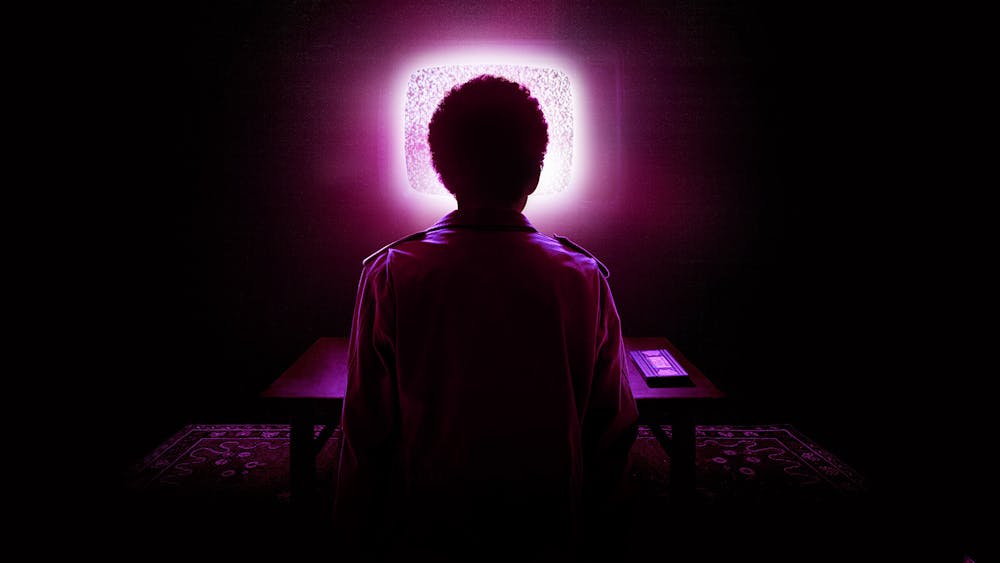“I Saw the TV Glow” is the second film from Jane Schoenbrun after their 2021 debut, “We’re All Going to the World’s Fair.” The new A24 film, which is slated for release on May 3, follows two teenagers named Maddy and Owen who bond over a midnight TV show called “The Pink Opaque.” After Maddy mysteriously disappears, reality starts to crack as we follow Owen’s descent into hysteria. The genre-bending film offers a deeper commentary on loneliness and gender, but it is nevertheless a puzzle in itself.
“I Saw the TV Glow” was shown at Middlebury on Thursday, April 18 as a part of the Hirschfield Thursdays series in Dana Auditorium.
After Owen and Maddie first watch “The Pink Opaque,” they drift apart and are only connected when Maddy leaves tapes of the show for Owen to watch. When she disappears, the only thing left behind is her TV burning in the backyard. Owen’s perception of reality starts to shift after this as “The Pink Opaque” becomes more than just a late-night TV show.
The film is visually stunning. If you too were obsessed with “Stranger Things” during the summer of 2022, you’ll love how certain scenes utilize light and color to create a sense of uneasiness. This low-key lighting creates a high contrast between dark tones and accents of color. The style is often used in analog horror or found footage films that Jane Shoenbrun knows well — the director demonstrated their ingenuity in that genre with their first film.
The aesthetics of the film helped to bring emotion out of the viewer even when the dialogue between the two characters was sparse. The contrast between cool, dark scenes and a recurring one in which Owen tends to a fire gives us a glimpse into his psyche. The darker scenes are accompanied by a cool tone that brings us into Owen’s world and creates a sense of loneliness. In contrast, the scene of Owen tending to a fire is a symbol for the warmth and solace Owen finds in “The Pink Opaque.”
The film’s grainy flashes hearken back to ’80s and ’90s nostalgia. The world of “The Pink Opaque” is campy, to say the least. The characters are something straight out of a pre-CGI ’90s horror film. Fans of camp movies or cult classics like “Killer Klowns from Outer Space” or “Tales from the Crypt” will love the horror aspect of the movie. The gaudiness and absurdity that the film entails is one of its highlights.
One of the best parts about “I Saw The TV Glow” is the soundtrack. The inclusion of tracks by Phoebe Bridgers and Alex G fit perfectly into the teen-oriented film and add to the melancholy of its protagonists. The theme “Anthems for a Seventeen Year-Old Girl” by Yeule emulates the atmosphere of the film better than any review can. With its stripped-back sound and underground elements that can only be found in the depths of “internet music,” it fits perfectly into the plot. The electronic accents on the song create the effect that you’re listening to a scratched CD rather than a digital recording, giving the feeling that there is a void that needs to be filled.
Growing up is painful, and both the film and the soundtrack encapsulate the feeling of being out of place. Alex G also wrote the score for “We’re All Going to the World’s Fair,” and he delivered just as much in his contribution for “I Saw The TV Glow.
Alex G is an anomaly. Calling his music indie rock would be doing a disservice since the melancholy sound produced can only be described as unnerving. The intentions behind the music are vital, as it’s meant to resonate with the characters who don’t feel comfortable in their own skin.
However, the lack of development of “The Pink Opaque” can make the film feel like it’s trying too hard to become a cult classic. The dialogue touches briefly on gender, but upon further analysis, the entire film is a commentary on how the characters are each outcasts in their small, suburban town due to their interests and sexuality. Ultimately, their bond is formed over their shared obsession with “The Pink Opaque.”
The plot, however, becomes convoluted when mixed in with the lack of dialogue, time jumps and lack of context. There are also scenes in which Owen narrates the story by addressing the audience directly but never shares his or Maddy’s insights. Though you want to develop some sort of connection to either of the characters, the dialogue is so limited and cold that the viewer is prevented from developing a true connection to either of the characters.
The coming-of-age aspect of the film is one of its biggest draws. The “Pink Opaque” lands somewhere between a kid’s show and a horror show that speaks to the feeling of not being a child, yet simultaneously having a fear of being an adult. As the two characters unravel their queer identities, parallelling the sense of freedom they find in “The Pink Opaque,” the theme of escape dominates.
Overall, Schoenbrun has created a film unlike any other. The cohesion between the visual aesthetics and the soundtrack creates a world that encapsulates the viewer and leaves them hanging on to every scene. The film blurs the genres of film and is enigmatic in both its plot and character development, challenging the audience to question the characters’ existence and sanity.




